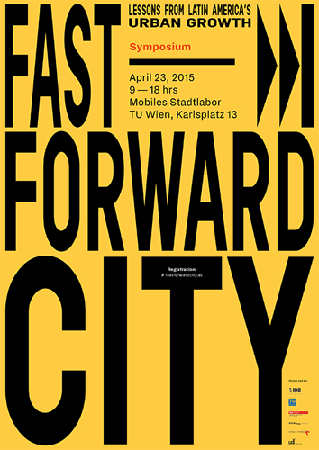Fast Forward City Symposium, Vienna, 23 April 2015

Henriette Vamberg, Partner Gehl Architects, Copenhagen, “The walkable City - Case studies of Latin America” mentioned so called “the Brasilia Syndrome” in the beginning of the presentation. The term was coined by Danish architect and urban designer Jan Gehl: "it [City] looks fine from the airplane, it may look fine from the helicopter down at the singular object but down between the buildings, nobody has given any thought to that… as far as I’m concerned, the people scale is the important scale in all of them.” (e.g. “Cities for People” by Jan Gehl).
People are pretty much the same as they were thousands years ago; they walk with speed 5 km per hour and have the same senses for this purpose. Urban designers should keep it in mind and make environment more attractive for walking. In addition it is really important to invite people to walk due to growing obesity among population. Such welcoming environment can be described by the following attributes: Protection, Crossing, Comfort, and Walking. There were many photos presenting concrete examples how the reality becomes a bit away from the ideal.
The rest of presentations were about cases of cities from Latin America.
Case study of the city of Mar del Plata (project ‘Urban Interventions in Public Spaces’ along with Gehl Architects and IDB) demonstrated the example of what can be done to improve the existing situation with minor intervention. Interesting facts revealed for example that 12 parking places may become 116 sitting places used not only for sitting by people but also for commercial activities like cafes.
You can read about Mar del Plata case more on the page about this project.
Alvaro Uribe from the Universidad de Panamá in his presentation “Metro Panamá and the Challenges of the Fragmented City” described several issues which Panamá City faces. He made a short introduction to the history of Panamá City mentioning historic sources of current city fragmentation started in early 20th century and underlined first attempts to solve the issue by Karl Brunner, Austrian architect in 1943. However in 1970s restrictions for the maximum height of buildings were relaxed and now city has many skyscrapers. Currently the fragmentation of the city increases problems of garbage collection and public transportation. Hence there was an idea to link all dispersed neighborhoods through metro realized recently.
Andrés Blanco, Sectoral Coordinator Emerging and Sustainable Initiative, IDB made presentation “Managing urban growth through Social Rental Housing” which was centered on the strong and weak sides of the social rental housing in Latin America. Currently 37% or 54 million families do not have access to good quality housing. At the same time about 9 million households are either homeless or live in substandard homes. This deficit in some part is qualitative which means lack of good infrastructure like electricity, water, sewage, unit conditions, and tenure. So infrastructure needs to be upgraded for families to have good quality housing however it is expensive to do. The other part of housing deficit is large number of unfixable houses and its general shortage meaning that these houses need to be built and subsidized.
There are good sides of the subsidized housing as well as not so good. The one not so good is the commute costs for the owner as typical locations of subsidized housing areas are on the outskirts of cities due to cost of land and its availability. However in many cases even such houses become not affordable for the owner as people cannot afford cost of commuting ,e.g. in Mexico City about 20% of such housing is vacant.
Such problems can be solved partly through rental market. Some examples of what can be done to make renting more attractive for the people were provided in the presentation along with work needed to change regulations and people’s attitude to renting houses.
Doris Tarchópulos, Municipal Planning Department Medellin, Colombia presented report “Challenges, Plans and Urban Projects” focused in integral program for improvement of district ‘PRIMED’. It is considered as an example of a successful experience in urban intervention like an improvement of houses, public spaces and other needs which made citizens actively involved. Also strategic plan for the city was mentioned including such topics as social urbanism and new urban territory. Medellin gains a lot from the new generation of civil society of leaders and new approaches to dealing with city developments.
Lea A. Ruefenacht, ETH Zurich Urban-Think Tank Chair made presentation “Promoting Culture, Innovation and Urban Sustainability - La Fábrica de Cultura en Barranquilla, Colombia” about project "Fábrica de Cultura" building in the heart of Barranquilla, Colombia. It was interesting to learn story of the project; what research its required and how space can play a significant role in the urban context. One may note that project was implemented under Creative Commons.
Wolfgang Loibl, from Austrian Institute of Technology made presentation “The IDB - Urban Growth Simulator” about decision support information tool for growing cities to model collective system behavior triggered by single decisions of a large number of individuals such as agent based models. He also mentioned town Mar del Plata which has 600,000 inhabitants but expects up to 8,000,000 tourists during summer seasons.
Horacio Terraza, Sectoral Coordinator Emerging and Sustainable Cities Initiative, IDB made presentation “Multisectoral Urban Development. Lessons learned from the Tegucigalpa Case” about projects in sustainable cities which are implemented by IDB and explained why IDB takes part in such projects. One of the reasons is that cities are engines of economic growth, they are hubs of innovation. He admitted also that cities are different and however there is a need for a benchmark system for which IDB uses 26 indicators of diagnostic analysis. Smart growth requires prioritization made with such tools as public opinion, economic cost criteria and development of action plan by multidisciplinary approach. Monitoring requires clear objectives to be set accordingly to selected indicators not only to see what’s going on but also to make proper decisions about city achievements.
Mr. Terraza provided example of city Tegucigalpa, Honduras which participates in the Emerging and Sustainable Cities Initiative (ESCI) among others five pilot cities and implements sustainable infrastructure projects. One of the challenges for Tegucigalpa is wastewater management and particularly the problem with the Choluteca River. It is hard to implement any urban intervention project along the river if the river itself is not clean.
The event was interesting, the presenters were passionate about theirs topics and tried best to involve public in the subject matters. During the conference and discussions Smart City Monitor by Pharos Navigator was demonstrated to Mr. Andrés Blanco, Mr. Horacio Terraza and Ms. Lea A. Ruefenacht as new IT application for monitoring, analysis, benchmarking and planning of the cities for sustainable urban development. The viewers expressed interest in the solution, underlined its innovative approach and simplicity of application.
2017 © GOLEM IMS GMBH, Austria. Все права защищены.
Правила предоставления сервиса |
Политика Конфиденциальности
Сделано в Австрии

